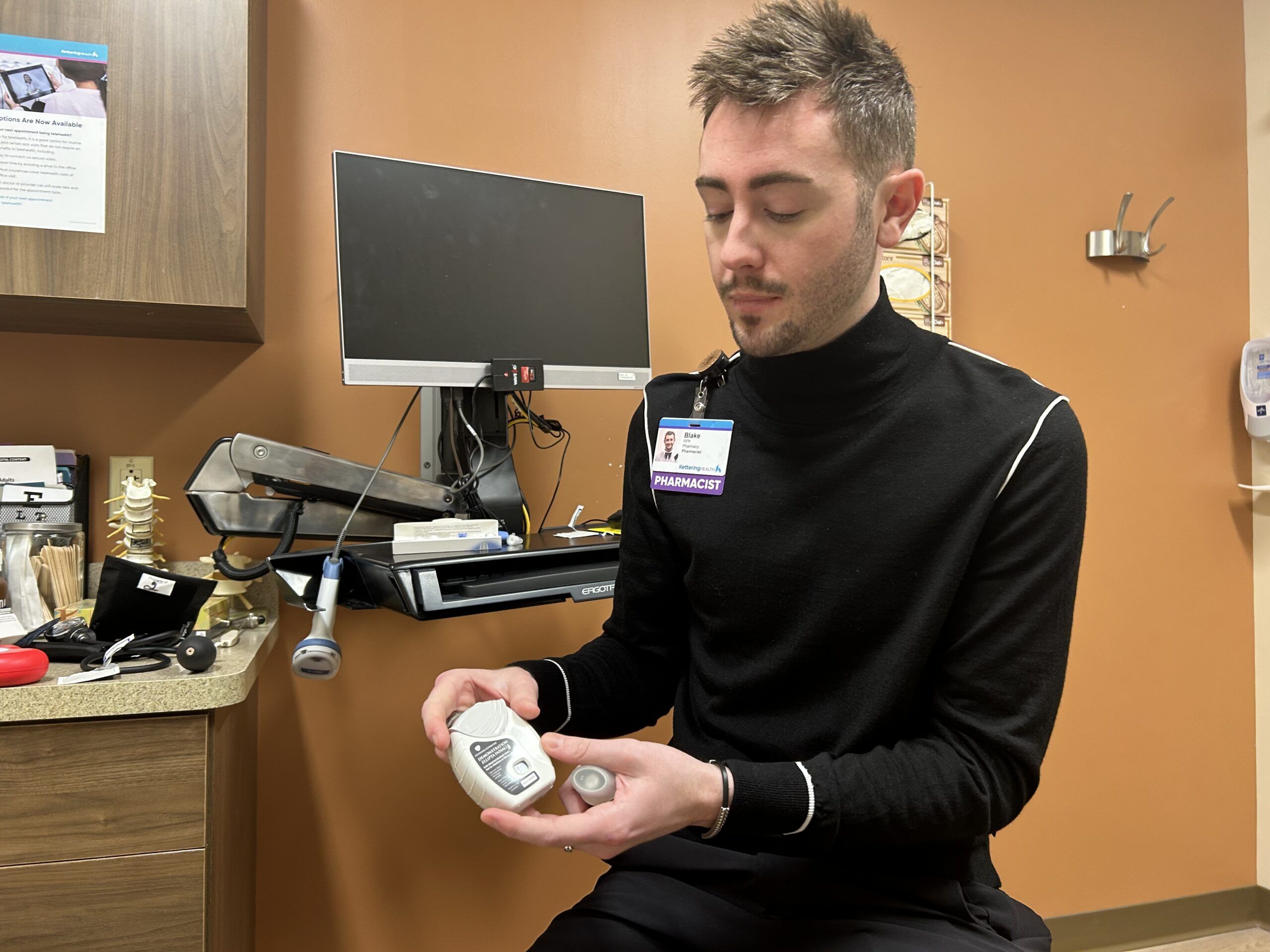Pharmacy
Want to learn more about this at Kettering Health?
At a Glance
Q: What do pharmacists do besides filling prescriptions?
A: Pharmacists are medication experts who educate patients, support doctors, and help improve treatment outcomes.
- Pharmacists explain prescriptions, side effects, and device use.
- They work in hospitals, cancer care, and primary care offices.
- Extensive training includes clinical rotations and patient counseling.
Most of us have the same mental image of a pharmacist—a friendly smile in a white lab coat standing between a cash register and a wall of pill bottles. Consider, though, how that person wearing the white coat does more than hand us our medicine.
“Traditionally, pharmacists were seen as prescription fillers,” says Blake Pitstick, PharmD, a clinical pharmacist serving in a primary care office. “But we’re healthcare collaborators. We’re educators and experts promoting the best possible outcomes.”
Pharmacists are instrumental, for doctors and patients. Sure, they fill prescriptions and ask if you have any questions. But they ask for a reason. Because they know what’s in the bottle, how it’s made, and how it will help you.
They’re experts, eager to answer your questions about this medicine and that vaccine and those medical devices—“because we want patients to feel confident and to feel better.”
Educators and experts
Pharmacists are oil wells of expertise. Beyond filling prescriptions, they translate and explain the complicated languages of health and medicine for patients, including
- A diagnosis, condition, or disease
- New prescriptions, over-the-counter medicines, and vaccines
- Possible side effects of medicine and combinations of medicine
- When and how to take multiple prescriptions
- The ins-and-outs of medical devices, such as inhalers, glucose meters, insulin injectors, etc.
But patients will sometimes avoid asking for help, for a variety of reasons. Blake, and his pharmacist colleagues, want you to know it’s better to ask for help than not. If you have questions, concerns, or even doubts, a pharmacist is equipped to help you.
“We often have the biggest breakthroughs with patients when they’re transparent and honest with where they’re at,” says Blake.
And you can find pharmacists “in a lot of different spaces throughout healthcare,” says Blake. “The opportunities are pretty much endless where we specialize and serve.”
Where to find a pharmacist
Before his days as a clinical pharmacist in a primary care office (as an ambulatory clinical pharmacist), Blake served in an outpatient oncology pharmacy, helping patients going through cancer treatment.
Similarly, pharmacists serve in
- Hospitals, working closely with hospital care teams, making medicine recommendations, confirming correct doses, and helping with discharge planning. This includes working with nursing units, answering questions and helping build treatment plans.
- Cancer care, providing expertise in cancer drugs, including choosing and monitoring those used in a patient’s treatment. These pharmacists also prepare chemotherapy drugs and counsel patients about their prescriptions.
- Palliative and end-of-life care, customizing treatment plans with care providers to improve symptoms of serious illness and the comfort of patients. They also help connect patients and their families to resources for emotional support.
You may not always see them since “pharmacists exist in a lot of the behind-the-scenes work,” Blake says. “But there is a good likelihood there is a pharmacist supporting the care going on.”
Training to be trusted
Pharmacists are required to complete extensive clinical training, earning their Doctor of Pharmacy (PharmD) through a six- or eight-year program. “Once you’re in pharmacy school,” Blake says, “those years are very rigorous.” Along with courses you might expect like the basic sciences (biology, chemistry, and anatomy and physiology), their training includes
- Medicinal chemistry (how medicines affect one another and the body)
- Pharmacy law and ethics
- Pharmaceutics (the making of medicine) and compounding (combining medicines for a patient)
- Counseling and communication
- Economics
- Epidemiology (the patterns, causes, and effects of different diseases)
And like physicians, pharmacists receive training through clinical rotations. “And these range from community and independent pharmacies to anticoagulation clinics (with services focused on patients taking blood-thinners), along with an array of inpatient specialties.”
The pharmacist’s evolving role
Over the past few decades, Blake points out, pharmacists’ training has become more extensive as their roles evolved. Pharmacists have become more central to the teams involved in direct patient care.
“One important role we take on is to come alongside our physician colleagues. We help free them up to see more acutely ill patients. And by doing so, we can help patients dealing with chronic disease and equip them to manage and control it.”
While they don’t diagnose patients, pharmacists are vital in helping physicians choose the best treatment options for a patient.
This is a central part of Blake’s role as an ambulatory pharmacist. By being in a primary care office, patients and their doctors have direct access to Blake. He, and his colleagues, can then help strengthen the connections between doctors and patients, providing greater clarity and confidence around potential treatments, their associated costs, and what’s best for the patient.
This unique approach also means Blake and other clinical pharmacists can “pump the brakes with patients. We can take time to connect dots, fill in gaps, and help patients feel more confident about what they’ve been prescribed before they leave.”
More than a white lab coat
This unique approach also means Blake stays busy in a primary care office. He might help someone diagnosed with asthma know how to use an inhaler, clarify for another why the flu vaccine is important, help with questions about COPD, and explain how a new prescription for diabetes is safe—all within a few hours.
He meets with patients and consults with doctors, both in-person and remotely. Having worked in other healthcare settings, he prefers primary care. “I really enjoy the one-on-one interactions I can have with patients.”
Like his colleagues, Blake is an expert care provider—who plays a much-needed role in patients’ lives and care. White lab coat not always included.










